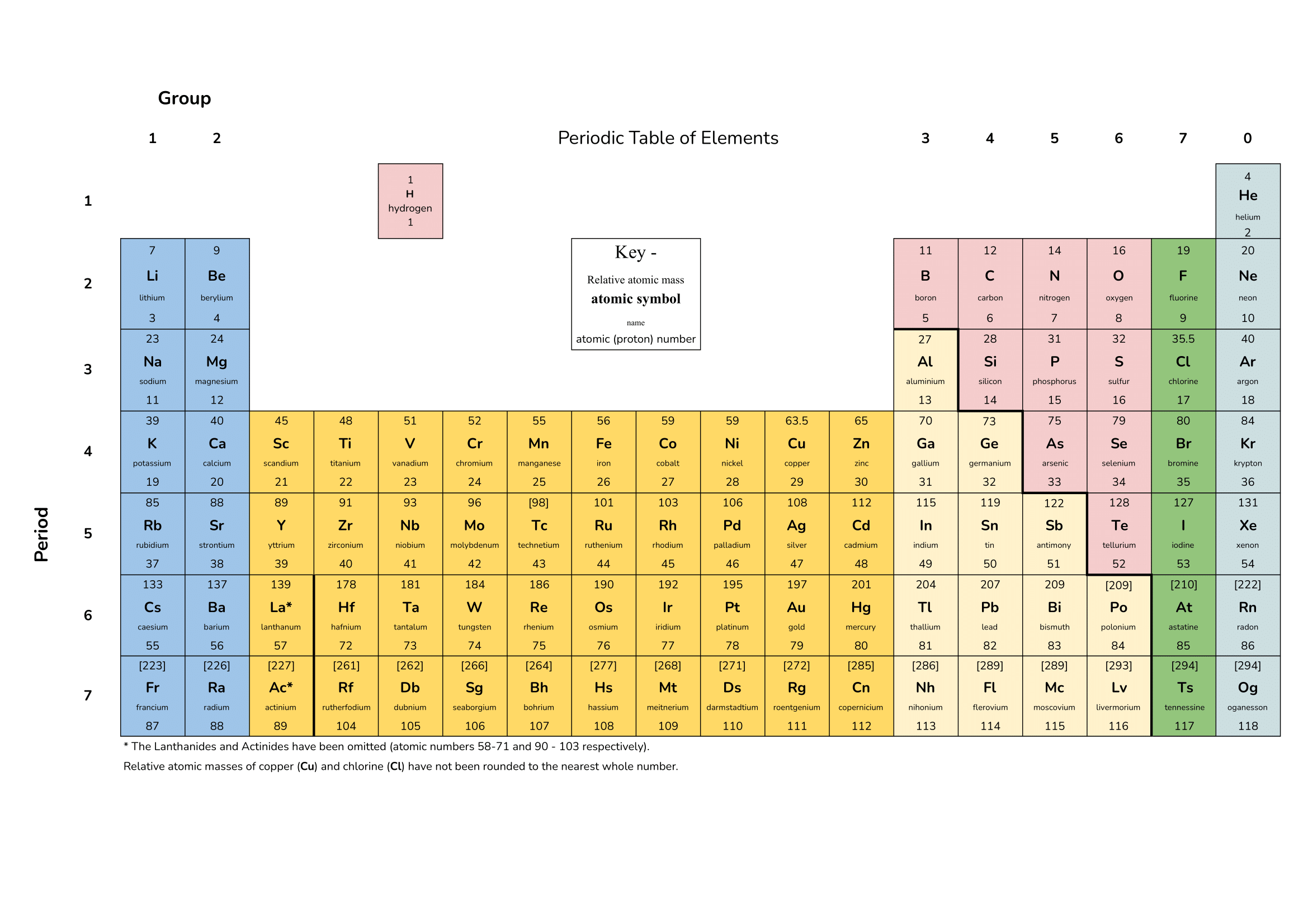Mock test. 1 hour and 15 minutes. 70 marks available.
GCSE AQA Combined Science Trilogy Chemistry Paper 1
Good Luck!
Quiz Summary
0 of 43 Questions completed
Questions:
Information
You have already completed this quiz. You cannot start it again.
Quiz is loading…
You must sign in or sign up to take this quiz.
You must first complete the following:
Results
Quiz complete. Results are being recorded.
Results
0 of 43 Questions answered correctly
Your Time:
Time has elapsed.
You have reached 0 of 0 point(s), (0)
Earned Point(s): 0 of 0, (0)
0 Essay(s) Pending (Possible Point(s): 0)
| Average Score |
|
| Your Score |
|
Categories
- Not categorized 0%
- 1
- 2
- 3
- 4
- 5
- 6
- 7
- 8
- 9
- 10
- 11
- 12
- 13
- 14
- 15
- 16
- 17
- 18
- 19
- 20
- 21
- 22
- 23
- 24
- 25
- 26
- 27
- 28
- 29
- 30
- 31
- 32
- 33
- 34
- 35
- 36
- 37
- 38
- 39
- 40
- 41
- 42
- 43
- Current
- Review
- Answered
- Correct
- Incorrect
-
Question 1 of 43Question 13 Points
Match the mass with the correct particle. Use some of the following numbers.
1, 2, 0, 1/1836
-
Protons =
Neutrons =
Electrons =
CorrectIncorrect -
-
Question 2 of 43Question 23 Points
Drag and drop to match the charge with the correct particle
- Protons
- Electrons
- Neutrons
- +1
- -1
- 0
CorrectIncorrect -
Question 3 of 43Question 36 Points
Use some of the following words to complete the statements below. You may use each word more than once.
Increase, increases, decrease, decreases, lower, higher
-
Complete the following statements about the trends in the properties of noble gases as you go down the group:
- Melting points . e.g. helium has a melting point than neon
- Boiling points . e.g. neon has a melting point than argon
- Density . e.g. krypton has a density than argon
CorrectIncorrect -
-
Question 4 of 43Question 41 Point
Which of the following items would you need to perform crystallisation by heating?
CorrectIncorrect -
Question 5 of 43Question 51 Point

This image shows the apparatus used during fractional distillation. What is the function of the fractionating column?
CorrectIncorrect -
Question 6 of 43Question 63 Points
Drag and drop to match the description and state of matter. Particles are:
- Liquids
- Solids
- Gases
- Close together and move around each other
- Close together and vibrate around fixed positions
- Far apart and moving quickly in random directions
CorrectIncorrect -
Question 7 of 43Question 71 Point
What do group one atoms do when they bond ionically with group 7 atoms?
CorrectIncorrect -
Question 8 of 43Question 81 Point
What is the electronic configuration of a nitrogen atom?
CorrectIncorrect -
Question 9 of 43Question 91 Point
What is the formula for the compound calcium nitrate which is made of calcium and nitrate ions (NO₃⁻)?
CorrectIncorrect -
Question 10 of 43Question 101 Point
What is the name of the force that holds together ions in ionic compounds?
CorrectIncorrect -
Question 11 of 43Question 111 Point
Which description most accurately describes covalent bonding
CorrectIncorrect -
Question 12 of 43Question 121 Point
Why do simple molecules not conduct electricity?
CorrectIncorrect -
Question 13 of 43Question 131 Point
Since metallically bonded atoms have a delocalised pool of electrons, these electrons are able to conduct ……
CorrectIncorrect -
Question 14 of 43Question 141 Point
Why are metals malleable?
CorrectIncorrect -
Question 15 of 43Question 151 Point
When a substance changes from a solid to a liquid, what happens to the mass?
CorrectIncorrect -
Question 16 of 43Question 161 Point
What are the melting and boiling points of water?
- Melting point
- Boiling point
- Neither
- 0˚C
- 100˚C
- 50˚C
CorrectIncorrectDrag and drop
-
Question 17 of 43Question 171 Point
The melting point of sodium is 97.8˚C and the boiling point is 883˚C. What state is sodium at 120˚C?
CorrectIncorrect -
Question 18 of 43Question 181 Point
Balance the following chemical equation.
-
Al + O₂ → Al₂O₃
CorrectIncorrect -
-
Question 19 of 43Question 191 Point
Balance the following chemical equation.
-
H₂ + O₂ → H₂O
CorrectIncorrect -
-
Question 20 of 43Question 201 Point
Balance the following chemical equation
-
Mg + O₂ → MgO
CorrectIncorrect -
-
Question 21 of 43Question 211 Point
Balance the following chemical equation.
-
HCl + NaOH → NaCl + H₂O
CorrectIncorrect -
-
Question 22 of 43Question 221 Point
Calculate the mass of fluorine needed to make 100g of magnesium fluoride. Consult the periodic table for all of the information you will need. Answer to one decimal place.
The balanced chemical equation for this reaction is:
F₂ + Mg → MgF₂
-
g
CorrectIncorrect -
-
Question 23 of 43Question 231 Point
Calculate the mass of oxygen needed to react with 20g of hydrogen to make water.
The balanced chemical equation for this reaction is:
2H₂ + O₂ → 2H₂O
-
g
CorrectIncorrectYou will need the periodic table to answer this question. A full explanation is provided at the top of the quiz
-
-
Question 24 of 43Question 241 Point
The mass before reactions is the same as after reactions, this is known as the Law of ……
CorrectIncorrect -
Question 25 of 43Question 251 Point
Chlorine has two stable isotopes, ³⁵Cl (75.77%) and ³⁷Cl (24.23%). Calculate the Aᵣ of chlorine to 2 decimal places.
CorrectIncorrect -
Question 26 of 43Question 261 Point
Calculate the relative formula mass of water. Hydrogen Aᵣ = 1, Oxygen Aᵣ = 16.
CorrectIncorrect -
Question 27 of 43Question 271 Point
Calculate the number of molecules in 16g of oxygen O₂.
CorrectIncorrect -
Question 28 of 43Question 281 Point
Calculate the mass of 25 moles of sulfur
CorrectIncorrect -
Question 29 of 43Question 291 Point
You have a sample of 788g of gold which contains 4 moles of particles. Calculate the Aᵣ of gold.
CorrectIncorrect -
Question 30 of 43Question 302 Points
Dividing, multiplying, 1000, 2000, 100
-
If a volume is given in cm³, you can convert it to dm³ by it by .
CorrectIncorrect -
-
Question 31 of 43Question 312 Points
-
Fill in the blanks to show the relationship between the different units of measurement for volume.
1dm³ = litre = cm³
CorrectIncorrect -
-
Question 32 of 43Question 323 Points
In an experiment to measure the rate of reaction of different metals with acids. The following data was collected by placing 1g of metal in dilute hydrochloric acid. The reaction produced a gas which was collected through a tube and its volume was measured with a gas syringe. The rate of reaction was determined by how quickly the gas was produced.
The data shows how much gas was produced in 10 seconds in cm³. Use the data to determine the order of reactivity from highest to lowest.
Iron – 4.4
Magnesium – 12.9
Lead – 1.7
Tin – 2.3
Calcium – 15.0
Aluminium – 7.1
- Iron
- Aluminium
- Lead
- Magnesium
- Tin
- Magnesium
View Answers:
CorrectIncorrect -
-
Question 33 of 43Question 331 Point
Place the metals in order of reactivity from high to low
- Iron
- Lead
- Copper
- Tin
- Zinc
View Answers:
CorrectIncorrect -
-
Question 34 of 43Question 341 Point
When using inert electrodes to perform electrolysis with molten lead bromide, which products will be produced at the anode and cathode?
CorrectIncorrect -
Question 35 of 43Question 351 Point
When using inert electrodes to perform electrolysis with sodium sulfate solution, which products will be produced at the anode and cathode?
CorrectIncorrect -
Question 36 of 43Question 366 Points
Use some of the following words to fill in the blanks. You can use each word more than once.
Copper, carbon, hydrogen, oxygen, less, more, electrolysis, heating
-
Complete the statements:
- Metals that are reactive than are extracted through .
- Metals that are reactive than are extracted by in a furnace.
CorrectIncorrect -
-
Question 37 of 43Question 371 Point

What is the term that is blurred in the diagram?
CorrectIncorrect -
Question 38 of 43Question 381 Point
Reaction profiles are used to show the energy transfers during reactions. Drag and drop to match the reaction profile to the correct type of energy transfer.
- Endothermic
- Exothermic
CorrectIncorrect -
Question 39 of 43Question 391 Point
Which of the following statements accurately describe catalysts?
CorrectIncorrect -
Question 40 of 43Question 401 Point
Drag and drop to match the reaction to the correct type
- Endothermic
- Exothermic
- Takes in energy, making the surroundings cooler
- Transfers energy to the surroundings
CorrectIncorrect -
Question 41 of 43Question 411 Point
In which type of reaction would the temperature of a solution increase?
CorrectIncorrect -
Question 42 of 43Question 423 Points
Drag and drop to match the description to the term
- Element
- Compound
- Mixture
- Contains only a particular type of atoms
- Contains more than one type of atoms, chemically bonded together
- Contains more than one type of atoms, but not chemically bonded together
CorrectIncorrect -
Question 43 of 43Question 436 Points
Match the change of state with the transition using the words below.
Freezing, sublimation, evaporation or boiling, condensation, melting, deposition
-
- Gas to liquid =
- Liquid to solid =
- Solid to liquid =
- Liquid to gas =
- Solid to gas =
- Gas to solid =
CorrectIncorrect -
Is this higher or foundation?
This is a combined paper for higher and foundation students. You can achieve grades 1 – 9 on this paper, so it is suitable for all. Grades are moderated against the average result to give the most accurate indication of your performance. You can look at – How is this paper marked? for more information.
How is this paper marked?
This paper is automatically marked to determine which questions were answered correctly.
Your grade is determined using a Z-Score moderation system. Your GCSE exams are also moderated comparably so that the difficulty of papers is taken into account.
Roughly, this works by calculating your overall percentage and comparing it to the average percentage and the standard deviation. This means that for harder papers you need fewer points to get the same grade as you would for an easier paper.
As more students attempt the paper, the average score and standard deviation more accurately represent the difficulty of the paper and the grades become more accurate.
Making these papers and the marking system took considerable effort so if you found them helpful for your revision, please show your appreciation by rating the page.
Which exam board are you studying?






